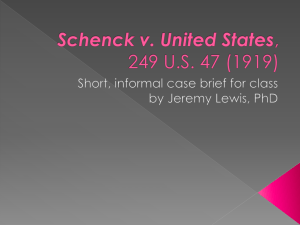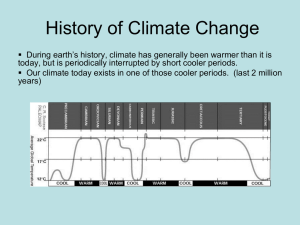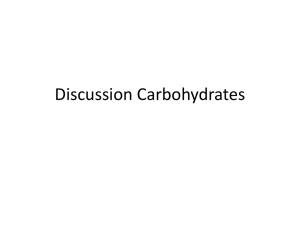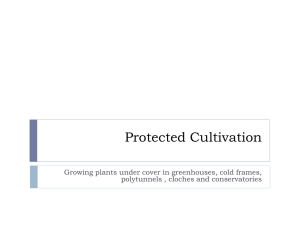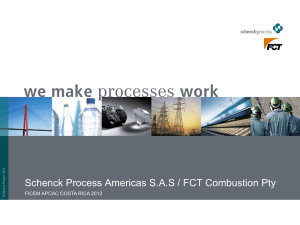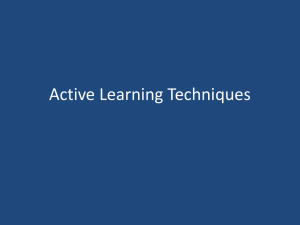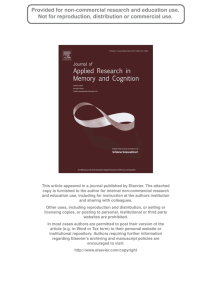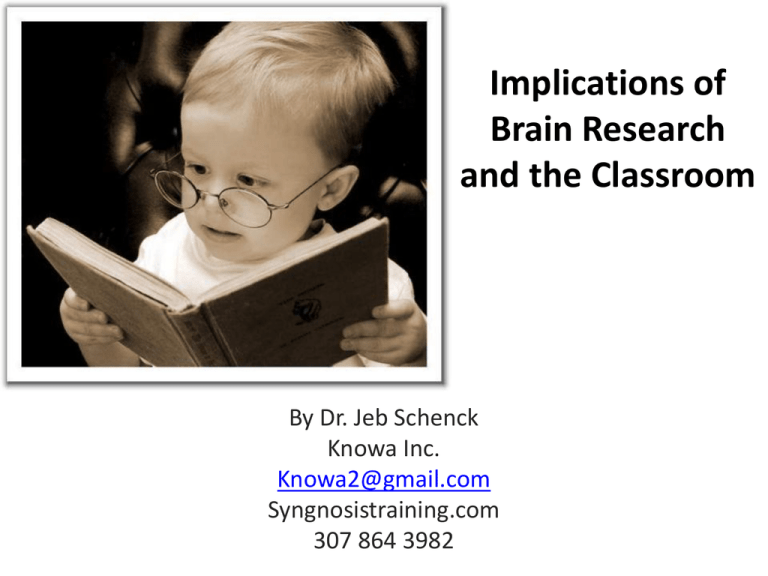
Implications of
Brain Research
and the Classroom
By Dr. Jeb Schenck
Knowa Inc.
Knowa2@gmail.com
Syngnosistraining.com
307 864 3982
Why Do We Need to Know
How the Brain Works?
Why Do We Need to Know
How the Brain Works?
And better informs our
leaders about which
policies, laws, and practices
actually agree with
neuroscience research
3 x 5 Card
List Three Things
1. Something you’ve heard about the brain works
2. Something about the brain you’d like to know more about
3. A practice or policy you think MIGHT NOT agree with research
More
Complicated
than Rocket
Science
More
Complicated
than Rocket
Science
Stephen
Hawking
finds the universe is
easier to understand
than the human brain
How Does The Brain Work ?
Where we are going:
•
•
•
•
•
•
The Brain & Learning
Brain’s Use of Patterns
Emotional & Attentional Processing
Movement & Memory building
Study Strategies/assessment
Making Useful Applications
Learning Takes Place HERE
A Learning Brain
Literally Grows Connections
Use It or Lose It
What Would Your Brain
Look Like
If you DON’T Use It?
In effect, all animals are under stringent
selection pressure to be as stupid as they can
get away with.
Richerson & Boyd,
Not By Genes Alone, 2005.
In effect, all animals are under stringent
selection pressure to be as stupid as they can
get away with.
Richerson & Boyd,
Not By Genes Alone, 2005.
The default state in solving
any problem
is to do as little as possible.
Brain in Default State
Modern Understanding
Started
With An Accident
Phineas Gage
SPECT SCANS
NORMAL
ADHD
ON ALCOHOL
Brain drawing/photo of lobes
& Where
Brain drawing/photo ofWhatlobes
Reasoning, impulse &
emotional control
Personality
Memory starts,
sound, emotional
tags
Vision
Balance
Heart , respiration &
sex drive (automatic
processes)
The Brain is Plastic
(Neuroplasticity)
To learn
It Must Change
Learning physically changes the brain
Brain Span vs. Life Span
Brain Span: 75 yrs
Life Span: 85-92 yrs
Increase Brain Span to match
Life Span
Some knowledge
about the brain is
becoming
common…but
misleading
Teen Brain Maturation
The Brain Grows
Everyone grows at
their OWN RATE
Different parts grow at
different times*
*It does NOT grow at the assumed rate of National/State Standards
Common recommendations for Literacy Have NO Neurological foundation
The 4,000 Year-old
Box of
Instructional
Methods
The 4,000 Year-old
Box
• If they don’t perform by a
specified time….
The 4,000 Year-old
Box
punish them
A Performance Goal is NOT
A problem…
if we keep it in line with brain’s
cognitive growth.
What is Red Shirting?
Why is it done?
• Brain Grows In CYCLES
Cycles in Cognitive Development
Skill Level
What Can They Do With a Lot of
Direct teacher
support
Support?
What Can They Do With No
Support?
Kurt Fischer 2008
Cycles in Cognitive Development
What Can They Do With a Lot of
Direct teacher
support
Support?
Skill Level
Teaching
Kurt Fischer 2008
Cycles of Brain Growth
• Many cycles in early years
•
•
•
•
10-12 Years
14-16 Years
18-20 Years
21-24 Years
(From K. Fischer, 2000)
Cycles in Cognitive Development
Principles
Multiple Abstractions
linked into systems
Direct teacher support
Abstractions linked
Single Abstractions
Skill Level
Independent or little support
8
12
16
Age in Years
20
24
28
Kurt Fischer 2008
Cycles in Cognitive Development
What Can They Do With Lots of
Support?
Skill Level
Direct teacher support
What happens if we push too fast for
that student ?
What Can They Do With No
Support?
Kurt Fischer 2008
Optimal Performance During Brain
Growth Spurt
• Optimal performance requires direct support/instruction vs
instruction by book or computer.
• Independent student performance is at a lower level
(suboptimal)…You don’t get best performance when they do
the task independently w/o coaching
• Students can’t transfer from an optimal level in one area to a
high performance level in a different area*
A Student Brain Develops Unevenly
(Out of Phase)
Reading Math
Comprehension is
here
Math computational
skill is here
Where Do You Expect the Student to
Perform?
Test level
Reading Math
Comprehension
Math computational
skill
Transfer—Problem Solving Fails when skills have not
developed
Incomplete Frontal
Lobe Development In
A Group
• What happens to judgment?
03.05. 07Dunk_Shot_1.wmv
• What happens to anticipating how others will feel?
• What happens to anticipating how they will feel?
Incomplete Frontal Lobe Growth
Incomplete Growth
•
•
•
•
•
•
Impaired decision making
More impulsive
Less emotional control
Lower ability to reason
Lower ability to see consequences
Lower ability to anticipate emotional impact
Fact vs. Fiction
Fact
Brain automatically organizes information
But it doesn’t
tell you How
Fact
• Overriding
impulsive actions ….
is harder because
frontal lobe isn’t fully
functional
Fact
Change the brain chemistry
and you’ve changed their
memory
FACT
How a question is
Asked
changes memory
FACT
• Recalled information
is reconstructed
from pieces
• Memory is being
REBUILT each time
you recall & use
information
Neuromyths
You use only 10%
If you used
only 90%
you’d probably
be in a coma
Neuromyths
Learning Preferences
Differentiate
• w/ levels of challenge
• w/ different modalities
Teaching and testing to a “learning style”
• Makes no difference, Roediger and Pashler, 2009
• Neurologically invalid, dubious, outdated information
(Schenck & Cruickshank, 2015)
• Wastes time,
• Wastes $
Neuromyths
• Right Brain-Left Brain training
• Ritualized movement produces higher performance (Brain
Gym™)
• Intelligence is fixed (can be expressed as a single number) The
Flynn Effect
• Learning can be expressed as a single number
• Preferred learning styles results in higher performances
Roediger and Pashler, 2009
Brain Break
4 minutes
• Stand and in groups of 3:
• Something that was new or
surprised you?
• Compare your “What do you
know about the Brain”
Systems of the Brain
How to Use them
Attentional Systems
Emotional Systems
Engaging the Brain
Engaging The Brain
Attention
Systems
Looks for Patterns
Tries to Make
Sense of Patterns
The Brain
must Recognize
Patterns to make
associations
Raise your hand when
you FIND TWO patterns
The Brain
must Recognize
Patterns to make
associations
Raise your hand when
you FIND TWO patterns
Detecting patterns heavily influenced by
1. Prior Experience
2. Brain Growth
3. Knowing What to Look For
The Brain
Associates Patterns w/Meaning
A pattern must be
Recognized
or students become
LOST
And Frustrated
Patterns
• May Have Emotional Significance
• Patterns Change our Focus of Attention
Attention
Systems
“ I’m Not inattentive,----you’re just boring.”
From Thom Hartmann
Attention Systems
• Systems are limited
• The brain can’t give full attention
to multiple tasks
= Divided attention
An
Demonstration of
Attention
Watch Video Clip
Of Student and Stranger
Multi-tasking Experiment
Can We REALLY Focus Our ATTENTION EQUALLY
On the Tasks?
Partner Up
You Need:
1 dollar bill or 3 x 5 card
Ability to count to 121
Watch Demonstration
Attention Systems
A student must ATTEND
to the lesson
No Attention =
almost NO CHANCE
of information getting into memory
No memory = No learning
Attention Strategies:
Physical—manipulate objects, or move the whole body, such as hands-on, role play,
draw, pantomime, build, model, standing a position, MUSIC (non-vocal)
Visual Imagery --imagine a picture or object, draw, sketch, build a model, design a
poster, create one power point slide for a group
Semantic –Reflect, summarize, describe, individually write, note-take, explain, tell,
NOTE THE DIFFERENCES and then SIMILIARITIES Between____________ ***
Social --have them watch & text answers/info to explain their partner’s actions
Sex Differences Girls are more attracted to activities where EMOTION can be
expressed, Boys more attracted to ACTION, MOVEMENT
*** Brain can recognize differences easily; similarities are difficult to tell apart
Attention Strategies:
The Student is
PHYSICALLY ACTIVE
during the learning event
The Brain SEEKS stimulation
If you don’t provide it,
the students find it for themselves
What Happens
If Left On Their Own?
+
=
+
The only brain getting benefit
of exercise is the dog.
No Engagement, No Activity = Little Learning
Brain Break
Stand, in groups of 2 or 3
Share With Someone Near You
The Most important thing about
ATTENTION is:
Something staff can do to increase
attention is:
Take 1 Minute
Compare with a neighbor
what you checked on
“What do you know about the Brain?”
Emotion
“Emotional Filter”
New Memories
Emotions
Enhance Learning
Hinder Learning
Emotions Affect Learning
If Emotionally Important,
Brain Pays Attention
Make the Connections With Someone
First…
then consider the
actual message
(Papanek & Greenleaf, 2005)
Emotional Significance
Do You Remember:
• Challenger blowing up, 9/11, the World Trade
Center?
• Your third algebra test?
• What you did on your 21st birthday?
• Your Wedding Night?
Emotions & Memory
• Chemically Made
• Changed by Threat or Depression
• Negative State NOT rapidly
dissipated
A Demonstration
• 4 volunteers who like Soda Pop
• ICE COLD soda pop
• FREE to 4 volunteers that will participate in….
To Increase Memory
• Tasks have greater personal importance
• Student is physically & personally involved
• Greater natural consequences that they care
about
• Increased Focus of Attention
• Light to Moderate Stress
Brain Break: 3 minutes
• Pair and Share:
• 1 idea to make a lesson have
more PERSONAL IMPORTANCE
to the student (and not
threatening!)
• In Groups of 4-5 Share ideas
Working Memory
• It’s what your
are thinking
about
!
RIGHT NOW
Attention + Emotions
Cowan, 2005
Working Memory is Very limited
Overload:
We Speak
10-20 Times Faster
Than A Student Can Write
AVOID Overload
Overload picture
1 Item
Focused Upon
Working Memory
3-4 Items Activated,
Readily Accessible
Working Memory
1 Item
Focused Upon
Working Memory
3-4 Items Activated,
Readily Accessible
•
•
•
•
Brain EASILY overloads
Focuses on ONE thing
Juggles several others
Leaves ONLY the gist
AVOID OVERLOAD
Working Memory Strategies
• Slow Down
• Don’t attempt several overlapping tasks
• Present instructions 4 ways (On board,
Verbally, In handout, On-line)
• Repeat back instructions
Working Memory Strategies
• Slow Down
• Don’t attempt several overlapping tasks
• Present instructions 4 ways (on board,
verbally, in handout, On-line)
• Repeat back instructions
Look At Handout:
What Administrators Should Know
On
2nd page: Working Memory
WHO Should Repeat Back the Instructions?
Working Memory Strategies
• Pause during explanations, lecture
• Provide skeletal notes to help organization
and reduce load
• Give Brain Breaks
• Use different colors to organize material
• Students actively process just 1 item
Brain Break
• Individually: Give an example
of how you will reduce WM
overload & write it down (2
min).
• Something YOU can do to
create Movement within a
long Staff meeting:
• In Groups of 3
Discuss examples
Long-Term Memory
Preparing for
Assessment
Long Term Memory ?
Remember Working Memory?
LTM Background
Hidden Factors in
Long-Term Memory
O
X
Mirror Drawing
Hidden Factors
A Demonstration
•
•
•
•
3 x 5 or 4 x 6 card
Mirror
Writing utensil
Mirror Drawing Practice Sheet & a hard surface
Prior Learning
Affects Current Learning
Memory Stabilizes
after 10-14 days
4th Grade
7
20%
6
Items Recalled
Discussion but uninterested
5
4
13%
Passive: No Discussion
3
2
1
0
1 3 5 7 9 11 13 15 17 19 21 23 25 27 29 31 33 35 37 39 41 43 45 47 49 51 53 55 57 59 61 63 65 67 69 71 73 75 77 79 81 83
Days
Schenck, J. (2003)
LTM
Affected by:
Development/age
Recognizing patterns
Attention
Personal Emotional Significance
Working Memory
Prior Learning
Method of Study & Test Practice
LTM
Affected by:
Development/age
Recognizing patterns
Attention
Personal Emotional Significance
Working Memory
Prior Learning
Method of Study & Test Practice
Strategies
To Build Memory
•
•
•
•
•
Personal Elaborations (Schenck & Cruickshank 2015)
Personal Applications (Schenck & Cruickshank 2015)
Space practices FAR apart *
Mix up the types of practice (Brown, Roediger, McDaniel, 2014)
NO cramming [Binge & Purge Learning] (Roediger & McDaniel
2014)
• Sleep on it
• Practice the TEST w/tests (uses RETRIEVAL CUES )
(Roediger & Karpicke 2006)
• In Math, do only 3-4 problems of same type
• Learning Styles have NO EFFECT (Pashler, McDaniel, Rohrer & Bjork,
•
2008)
* Start with the Assessment Goals & Design Practices to them
Practice Tests
Practice Test Methods
SSSST
TESTe, Sm, Te, Sm, Te
W I D E Equal Spacing, or Variable Spacing
No Cramming
Limit practice of same type of problem
No Rereading
• Practice of transfer w/application
Cahill, & McGaugh, (1995)
Callender, & McDaniel, (2009)
Karpicke, J., Butler, A.C., & Roediger, (2009)
Rohrer, D., & Pashler, H. (2007)
Practice on Same Type of
Problem
• More than 4 creates Cramming Effect &
illusion mastery because problems are
familiar.
• AVOID cramming by spreading practices
out over weeks.
ReReading
Increases familiarity
Faster recognition
&
Creates False Sense of Understanding
Chabris & Simons 2010
ReReading
• Does not increase depth of knowledge
• Does not create new-linkages in brain
• ELABORATING does help…Explain WHY
• The student must explain the connections
• Elaborate While
Personally Engaged
=
More Robust Memory
Practicing Transfer
• Practice Conditions (A. Baddeley)
• Level of difficulty (K. Fischer; Craik & Lockhart)
• Number of Skills Practiced vs. Skills
Assessed (Theo Dawson, DTS)
Most Powerful &
Long-Lasting
Mind Map that can
be Manipulated
Mind Map that can
be Manipulated
1. Objects have unique shape
2. Objects have color
3. Can be in sequence or nonsequential
4. Student moves & explains
5. Provides immediate feedback
6. Creates multiple forms of
memory
7. Faster than writing or
lecturing
8. Practice to mastery or past
perfection (abt.3-5 times)
Developmental Differences
12 & 10th grade LTM
for Complex, Abstract Material
100
92
12th Grade
10th Grade
90
70
80
70
60
60
50
32
40
30
20
10
0
Mind Map
73 Days
Lecture
Mind Map
37 Days
Lecture
Getting Personal
Metacognitive Strategies
•
•
•
•
Personal Involvement
Personal Elaboration
Physical Movement Elevate Respiratory and Heart Rates
Prompt feedback (within 1day-- not longer than about 2
days, No help after a week ---Dweck)
• Meaningful personal consequences that are nearly
immediate --They see their approach doesn’t work—as in a video
game.
Poor Test Prep
Causes of Poor Performance
• Forgotten RETRIEVAL CUES, not the information
(It is still there)
• Mistakes Familiarity with Mastery ( “But I did a lot of the
problems”)
• Used Massed Practice (in either academics or Sports
tested extensively at college & pro levels– Spread out the practice tasks,
avoid “massing”)
• Practices too close together
• Unskilled and Unaware of It
• Too Much Screen Time
Brain Break
With A Partner:
The most important thing
for TEST PREP is:
Something I need to AVOID
I can HELP students prepare
by….
Ultimately….
Two Brains
Must be
Trained:
Yours & Theirs
For PDF’s contact:
Dr. Jeb Schenck
Knowa Inc.
Knowa2@gmail.com
307 921-8906


